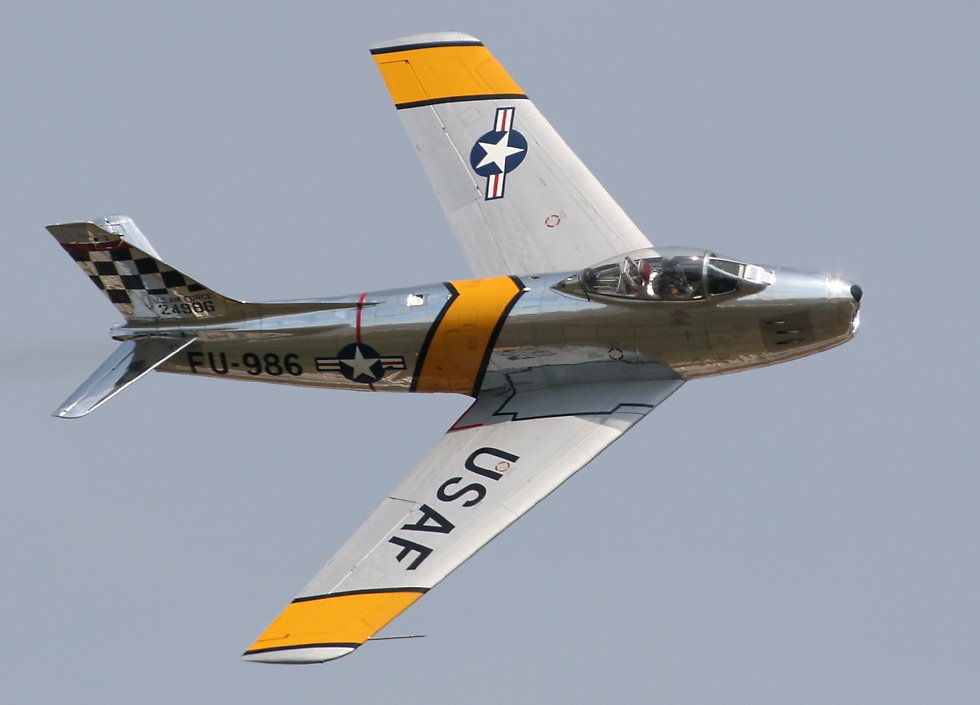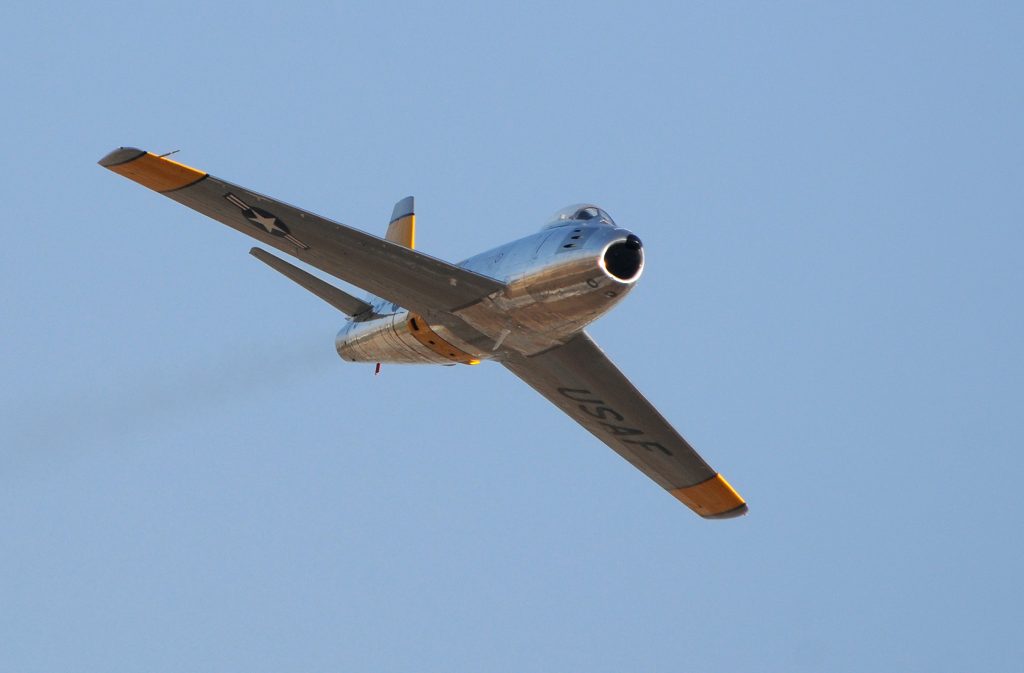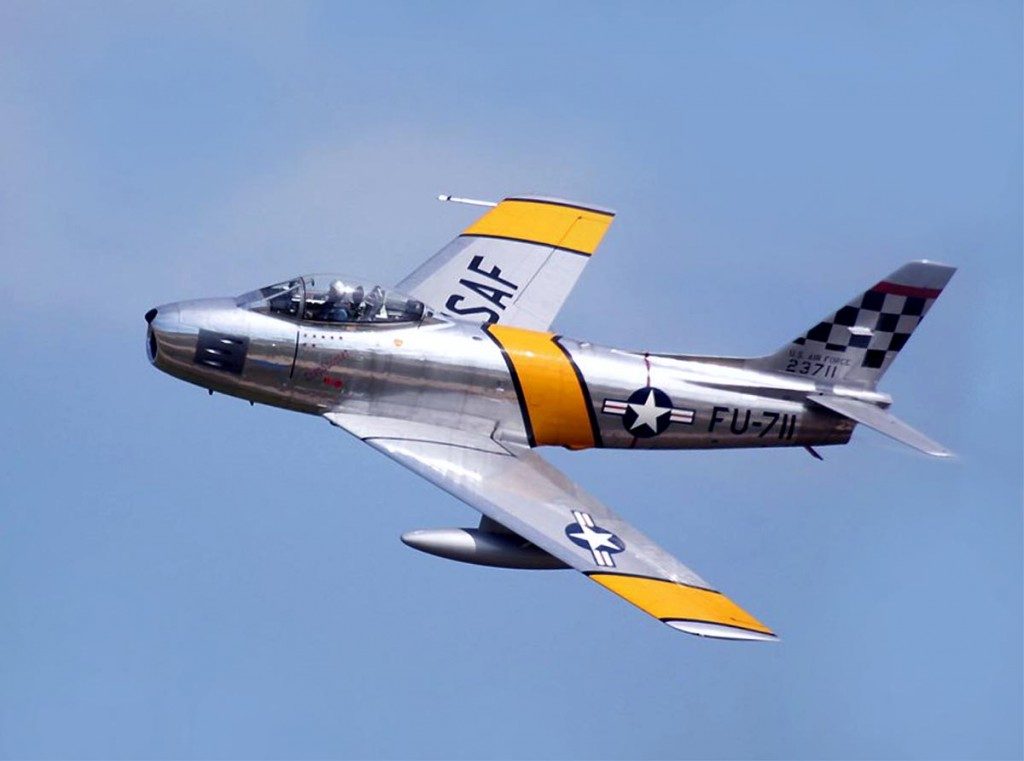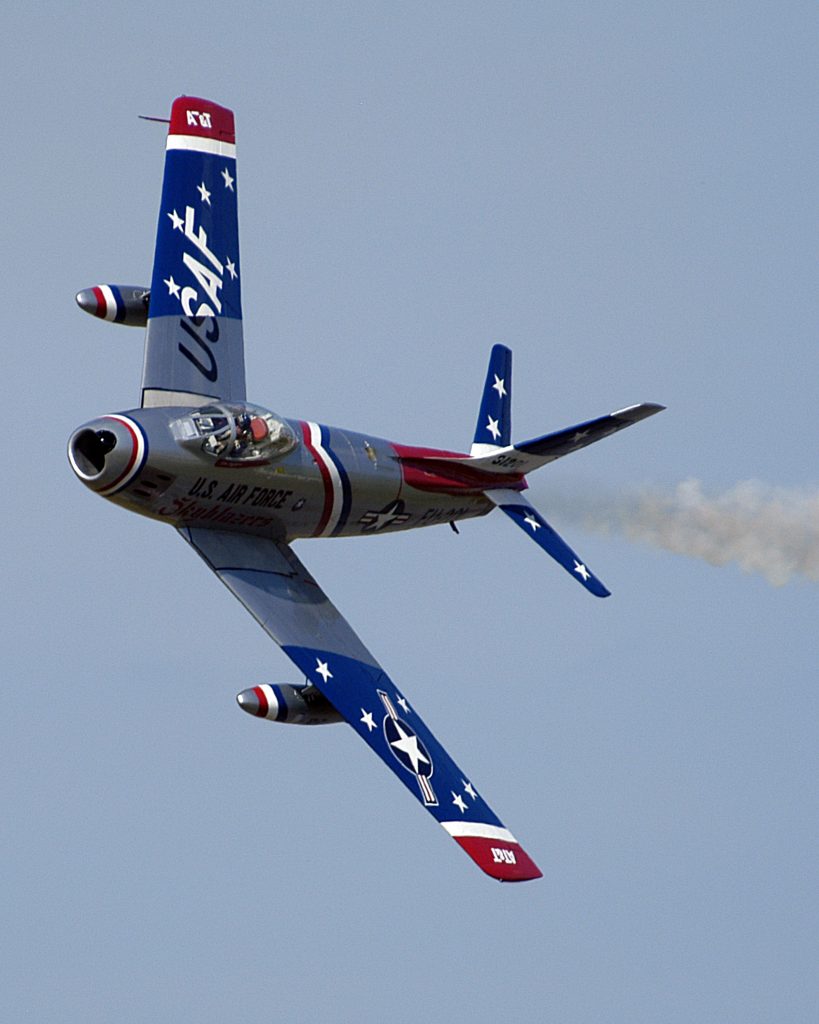The F-86 ‘Sabre’ is certainly one of the most beautiful aeroplanes from the Cold War era, and is an icon of the classic jets genre.
First used in combat in the Korean War, the Sabre soon proved itself to be the best of the fighter aircraft in the United Nations’ arsenal, and it was the only fighter capable of facing the North Koreans’ MiG-15 fighters on equal terms. Other fighters fielded by the UN were either slower piston-engined prop jobs like the F-51 Mustang, or straight-wing jets such as the Lockheed F-80 Shooting Star and the Gloster Meteor, which were a good deal slower than the MiG-15.
But the Sabre was fast (it was just supersonic in a shallow dive), manoeuvrable, had good visibility from its bubble canopy, and was often flown by experienced combat veterans who had fought in WWII. In many ways, the Sabre and MiG-15 were virtually equal aircraft, each with strengths and weaknesses with respect to the other, very much like the Spitfire and the Messerschmitt 109 were in the Second World War. Here are a preserved Sabre and MiG-15 seen together at an airshow in the USA (photo is clickable to magnify):
But the Sabre is just plain beautiful, and that’s one reason why I’m featuring it in ‘Beautiful Destroyers‘. Look at those lovely clean lines, the perfect wing sweep angle, the sleekness of the curves of the fuselage…this is a beautiful aeroplane in the same league in the beauty stakes as the Hawker Hunter.
In the photo above, you can clearly see the ‘bubble’ shape of the canopy; this gave the pilot an excellent all-round field of view; this is very advantageous in close-in air combat. There is an old fighter-pilots’ adage: ‘He who sees, wins’ and the Sabre’s canopy certainly fits the bill for that purpose.
Armed with six 0.50″ machine guns, the Sabre packed quite a punch – the six 0.50-cal machine guns were a proven weapons fit from the Second World War – but they did not have quite the range of the cannon with which the Soviet fighters like the MiG-15, and jet bombers like the Ilyushin-28, were armed.
Indeed the early Sabres were in some ways some of the last of the gun-only armed aircraft; changes in the performance of jet bombers meant that there had to be new developments in air-to-air combat that would enable fighters to bring down Soviet bombers which had nearly as good speed and altitude performance as the fighters that would be trying to stop them in the event of a war.
Eventually, the ability to stop fast jet bombers was realised by the advent of air-to-air guided missiles; indeed the Sabre was one of the first aircraft to be fitted with early versions of the AIM-9 ‘Sidewinder’ heat-seeking missile. But in the meantime, other methods had to be developed to enable interceptors to attack enemy bombers without being exposed to withering cannon fire from the tail turrets of aeroplanes such as the Tu-95 ‘Bear’. (Remember that at this time in history, the ‘Cold War’, the threat of nuclear war was ever-present, and the West and the East both poured tons of money into developing effective defences against enemy nuclear-armed bombers). The temporary stop-gap measure adopted by the USA and Canada, at least, was to arm their interceptor jets with many unguided ‘folding-fin aerial rockets’ (FFARs) which had explosive warheads but which had to actually hit their targets directly in order to cause damage. A good number of these rockets were carried by various interceptors, from 24 in the F-86D (below) and F-102A, to a massive 108 FFARs in the Northrop F-89D ‘Scorpion’. The idea was to attack enemy bombers using a single head-on pass, using a specialist radar-guided attack computer which launched all the FFARs at the target in one (hopefully devastating) salvo. Hopefully, the combination of reasonably accurate aiming and the ‘shotgun’ effect of having so many FFARs in the air at the same time, would bring down the enemy bomber before it got to its target. That’s what interceptors are supposed to do.
And so was born the F-86D ‘Sabre Dog’; the FFAR-armed interceptor version of the F-86. The inclusion of the fire control radar and the retractable rocket tray meant that the airframe shape was nowhere near as graceful as the gun-armed F-86s, but I suppose it was for a reason and it did its job. The F-86D was never intended for fighting against enemy fighters, though; its entire armament for its mission was based around the single salvo of FFARs, to be used to intercept a single enemy bomber. You only got the one shot. Here is the F-86D, and another shot showing its retractable rocket tray, which was just under the cockpit:

The big black dome on the nose of the Sabre Dog (which I feel spoils its lines!) is the radome containing the fire control radar for the FFAR aiming computer. Here’s another shot of the whole FFAR salvo going off:
Impressive though that looks, this technique is of questionable value at best; it was appallingly inaccurate, and it was fortunately never really necessary to use it for real, in this role at least. (See the Wikipedia article on FFARs for more on this)
Now, this is more like it. Here is a gorgeous painting of an F-86 punching off its drop-tanks as it prepares to engage a North Korean MiG-15:
Drop tanks were an idea from the Second World War, where fighters could extend their range by carrying extra fuel in external tanks. Because these external tanks increased the weight and drag of the aeroplane, they could be dropped, or ‘punched off’, as the enemy was sighted, hence the name ‘drop tanks’.
The fighter would then be lighter and cleaner and better able to engage the enemy. The idea was that you would use the fuel from the drop tanks first, so that the tanks would hopefully be empty by the time you ran into trouble and jettisoned them. Or, if you didn’t make contact with enemy aircraft, you could just bring the tanks home empty and use them again.

The Sabre served with many nations’ air forces , including the Royal Air Force, for many years and in many operational theatres, with the last ones being retired from service in the Bolivian Air Force in 1994.

So, there she is; the F-86 Sabre. Beautiful lines, sleek, fast and deadly. A ‘Beautiful Destroyer’ for sure.










